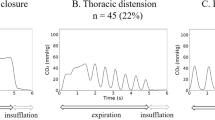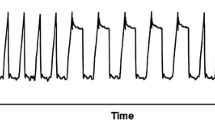Abstract
Capnography is an effective and non-invasive method for monitoring patients during general anesthesia and can reflect the changes in both the respiratory function as well as the circulatory function. In this paper, we present four cases of lobectomy in which we observed a “chair-like” waveform on performing capnography after the surgery. In all the cases, the appearance of this “chair-like” waveform led to the suspicion of a blockage in the pulmonary artery perfusion, which was then confirmed to be an obstruction in the pulmonary artery on further investigation. This suggests that during lobectomy, capnography can help confirm that the pulmonary circulation is unobstructed. We believe that it is very important to observe the changes of end-tidal carbon dioxide pressure and capnogram during one-lung ventilation, particularly in cases of pulmonary artery anastomosis.






Similar content being viewed by others
References
Kwok WH, Wong MK, Ho AM, Critchley LA, Karmakar MK. Left mainstem bronchial tear manifesting as sudden upsurge in end-tidal CO2 during thoracoscopic tracheoesophageal fistula repair. J Cardiothorac Vasc Anesth. 2013;27(3):539–41. https://doi.org/10.1053/j.jvca.2012.05.013.
Siobal MS. Monitoring exhaled carbon dioxide. Respir Care. 2016;61(10):1397–416. https://doi.org/10.4187/respcare.04919.
Garg R, Murthy K, Rao S, John C. Utility of intra- operative capnogram to detect branch pulmonary artery obstruction following totalcorrection of tetralogy of Fallot. Ann Card Anaesth. 2011;14(1):45–7. https://doi.org/10.4103/0971-9784.74399.
Bonderman D, Lang IM. End-tidal CO2 for exclusion of suspected pulmonary embolism: a new partner for Wells? Eur Respir J. 2010;35 (4):723–4. https://doi.org/10.1183/09031936.00164309.
Blankush JM, Freeman R, McIlvaine J, Tran T, Nassani S, Leitman IM. Implementation of a novel postoperative monitoring system using automated Modified Early Warning Scores (MEWS) incorporating end-tidal capnography. J Clin Monit Comput. 2017;31(5):1081–92. https://doi.org/10.1007/s10877-016-9943-4.
Ward KR, Yealy DM. End-tidal carbon dioxide monitoring in emergency medicine, part 2: clinical applications. Acad Emerg Med. 1998;5(6):637–46.
Qvigstad E, Kramer-Johansen J, Tømte Ø, Skålhegg T, Sørensen Ø. Clinical pilot study of different hand positions during manual chest compressions monitored with capnography. Resuscitation 2013;84(9):1203–07. https://doi.org/10.1016/j.resuscitation.2013.03.010.
Author information
Authors and Affiliations
Corresponding author
Rights and permissions
About this article
Cite this article
Shu, J., Zhang, K., Chen, Y. et al. Using the capnogram to assess pulmonary perfusion during a lobectomy: case studies. J Clin Monit Comput 33, 1061–1064 (2019). https://doi.org/10.1007/s10877-018-00249-w
Received:
Accepted:
Published:
Issue Date:
DOI: https://doi.org/10.1007/s10877-018-00249-w




